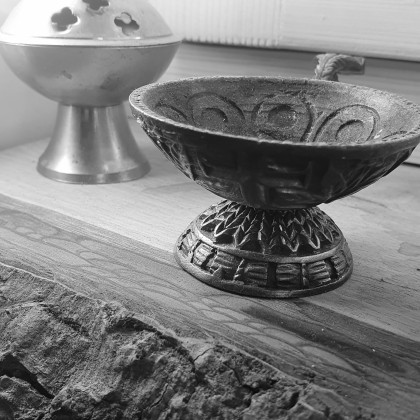ArachnoTube(son)
Community Answer
Community Answer
Call a friend to remove it, or use it as an opportunity to face your fear.
Not Helpful 18Helpful 20
Question
What do I do if my home is infested with lots of spiders?
Community Answer
Community Answer
Call a reputable pest control service.
Not Helpful 2Helpful 10
While most people would consider spiders to be unwelcome house guests, you don't have to kill them and can instead use a catch-and-release method to make your home spider-free. There are a few simple methods you can use to catch the spider and guide it outside. Even if you are afraid of spiders, you will be able to use these methods and have minimal contact with the spider. Before capturing the spider, you will want to make sure it's not venomous so that there is no risk of being bitten and needing to seek medical care.
5
Check for baby spiders. The presence of baby spiders can also indicate that you have found an egg sac. Female spiders can lay hundreds of eggs in an egg sac, and when the eggs hatch, lots of tiny spiders may start crawling out of the sac.[8]
If you see any small, pale-colored spiders crawling around what you think might be an egg sac, then it probably is one.
Wooly webs. Slightly sticky webs with an indistinct shape.
Image titled Identify Spider Egg Sacs Step 6
2
See where the web is located. Spiders make their homes in all sorts of places. You might find a web in a hole in a brick wall, the corner of a room, a tree, or a pile of dead leaves.[11] Considering the location of a web will help you narrow down the possibilities for what type of spider’s eggs you are looking at.[12]
For example, tarantulas often live in burrows in the ground with a thin web covering the opening, disc web spiders often make their small grey webs on tree bark and brick walls, and comb footed spiders often make their webs in houseplants.[13]
Image titled Identify Spider Egg Sacs Step 8
3
Get a good look if you can. Because many types of spider egg sacs look similar, it can be difficult to identify one without seeing the spider that left it. Some spiders lay their eggs and then depart, in which case you won’t see them around, but a number of them will stay close and protect the eggs until they hatch.[14]
If you do find the spider that made the egg sac you are trying to identify, getting a good look at the spider is your best chance at getting an accurate identification.[15]
Image titled Identify Spider Egg Sacs Step 9
4
Pay attention to the coloration. Spiders come in many different colors and patterns. Some, like the distinctive Black and Yellow Garden Spider, are immediately recognizable, while others are more common looking.
Try to notice the details. For example, if the spider is brown, what shade of brown is it? Does it have any other markings? Is it the same shade of brown over her entire body?
Image titled Identify Spider Egg Sacs Step 10
5
Notice the hair. All spiders are covered with small hairs, but this is not always noticeable. If you do see hairs on a spider, try to think of how you would describe them.
For example, does this spider have hairs that are visible from a distance, like the Bold Jumping Spider, or are the hairs practically invisible even up close, like the hairs on a Brown Recluse?
Image titled Identify Spider Egg Sacs Step 11
6
Gauge its size. Many people are afraid of spiders, so it can be easy to mentally exaggerate how large one is. However, getting an accurate way to describe the size of the spider may make it easier for you to identify it.[16]
Try to be objective. Is the spider the size of a pencil eraser? A quarter? A golf ball? Your fist?
Most species of spiders have an average size range in inches or centimeters. Try to estimate its size in inches or centimeters to help you as you try to identify it.
Community Q&A
QuestionCommunity Answer
Spiders cannot lay eggs in your skin by biting you. This is an urban legend.
Not Helpful 12Helpful 66
Question
How do I get rid of tiny egg sacs containing spiders that are all over my house in clothing, cabinets, food, etc.?
Community Answer
Community Answer
I just used the vacuum cleaner and got rid of all the spiders sacs in the loft. Make sure you change the bag of the vacuum cleaner afterwards.
Not Helpful 4Helpful 35
Question
I found a big, white sac attached to the back of a wooden pole on my bed, but there was no spider there. Any ideas what kind of spider it may be?
Community Answer
How many babies are in a spider egg sac?
wikiHow Staff Editor
wikiHow Staff Editor
Staff Answer
The amount will vary from species to species but generally there will be a large amount of spider babies in any egg sac, as the aim is to get at least one of those babies to reach adult spiderhood. The majority of the spider babies will be eaten, squashed, killed or die from exposure before ever having the chance to grow up. A quick glance at numbers from varying species of spiders suggests that spider sacs can contain anywhere from 2 to 2000 baby spiders, depending on the species.
Not Helpful 6Helpful 20
Question
How do I remove an egg sac from my windowsill?
wikiHow Staff Editor
wikiHow Staff Editor
Staff Answer
You can use the tip of a pencil or chopstick, or similar object, to ease the egg sac away from the corner or edge of the sill that it's adhered to. Wiggle the object gently to ease the sac away, then scrape or sweep it into a container. You can drop the sac into the garden or outdoors; most of the spiderlings won't survive but one or two might grow into adult spiders if they're lucky. If you have leftover bits of the sac, wipe away with a piece of paper towel and a little all-purpose cleaner to tidy up.
Not Helpful 8Helpful 15
Question
My sister saw a spider and took a picture of it; after zooming in closely we noticed a colored lump on one of its legs. Looked like fluid. What is this?
wikiHow Staff Editor
wikiHow Staff Editor
Staff Answer
Quite possibly this is a piece of fluff from a fabric object in your home, such as carpet, rugs, clothing or soft furnishings. Without seeing the spider and this colored "lump," it's not possible to say whether or not it's meant to be part of the spider. However, it's not unusual for insects and spiders to attract or get caught up in tiny threads, bits of fabric fluff, etc. found in the home environment.
Not Helpful 6Helpful 13
Question
How do you get rid of spider egg sacs?
wikiHow Staff Editor
Part
2
Observing the Spider and Web
Image titled Identify Spider Egg Sacs Step 5
1
Note the pattern. Different kinds of spiders weave different kinds of webs.[9] Observing the web will not be possible in all cases, as not all spiders leave their egg sacs in their webs. However, if you can’t tell what kind of spider you’re dealing with just by looking at the egg sac, then it is a good idea to check out the web. Common spider web patterns include:[10]
Orbs. Circular patterned webs.
Cobwebs or tangle. Messy looking fluffy webs that often appear in the corners of ceilings.
Funnels. Webs in the shape of a tunnel that are located in low-traffic areas.
Sheet webs. Flat sheet-like or bowl-shaped webs.
wikiHow Staff Editor
Staff Answer
In general, spider egg sacs are easy to get rid of. You can use such methods as vacuuming or using an oil-based pesticide. For details on what to do to get rid of spider egg sacs, see How to Kill Spider Eggs.
Not Helpful 8Helpful 11
Question
What does a spider poop look like?
wikiHow Staff Editor
wikiHow Staff Editor
Staff Answer
Spider poop has an appearance similar to the poop of insects––you’ll see what appear like specks in varying colors of brown, white, black, etc. If fresh, the poop is liquid in much the same way as bird poop, only much, much smaller.
Not Helpful 4Helpful 13
Question
Do all spiders make egg sacs?
wikiHow Staff Editor
wikiHow Staff Editor
Staff Answer
Yes, most spiders make egg sacs for reproduction. These sacs may be tended or abandoned by the mother spider, depending on the species. Spider egg sacs can be found in a variety of different places, including in webs, bark, leaves, wood piles, building crevices, etc., the placement dependent on the species.
4
Guide the spider over the threshold. The spider may hesitate on the threshold as it is running toward the door. If the spider lingers on the threshold, brush it out using your hand or the notebook or folder. You also could flick it with your finger.
Image titled Get Spiders Out of Your House Without Killing Them Step 5
5
Throw the folder out the door if the spider crawls on it. When you are using the folder to guide the spider out of the door, the spider may start crawling on the folder instead of running. If the spider crawls onto the folder, toss the folder out the door, so that both the spider and the folder are outside. The spider will eventually crawl off the folder, and you can go and retrieve the folder later.
You may not feel comfortable throwing the folder out of the door or window, especially if you live in a communal space like an apartment complex. If the spider crawls on the folder, instead of throwing it you can go outside with the folder and either brush the spider off with your hand, or wipe the folder on a bush or the windowsill until the spider falls off.
Image titled Get Spiders Out of Your House Without Killing Them Step 6
6Not Helpful 9Helpful 24
Question
What shall I do if I find it on my arm?
Community Answer
Community Answer
Shake it outside if you are brave enough, otherwise shake it onto a counter, then try one of the methods.
Not Helpful 8Helpful 23
Question
Keep in mind that some spiders make just one egg sac, while others make several small ones.
Image titled Identify Spider Egg Sacs Step 3
3
Look at the color. Most spiders create egg sacs that are white or off-white. However, this is not true of all egg sacs. Some eggs sacs are brown, yellow, or even yellowish-green.[5] [6]
Observe the color to determine if what you are looking at might be a spider egg sac. For example, if the color of the sac is pink or black, then it is probably not a spider egg sac.
Image titled Identify Spider Egg Sacs Step 4
4
Pay attention to the location. While some spiders carry their egg sacs around with them, most spiders leave their egg sacs suspended in a web.[7] If you have spotted something that you think might be a spider egg sac, check to see if it is suspended in a web or attached to a wall or other surface with some silk webbing.
Some species of spider lay their eggs in sacs that are on the ground, so there might not always be visible webbing.
Image titled Catch a Spider Step 3
Community Answer
You should get a cup and some paper and put the cup over the spider and slide paper underneath it. Then, take it outside and dump out the cup away from your house.
Not Helpful 22Helpful 15
Question
What if the spider is in its web?
Community Answer
Community Answer
If the spider is in its web, you can capture it with a cup, followed by covering it with a folder and leaving the cup outside so that it can crawl out.
Not Helpful 6Helpful 13
Question
What if you are afraid of spiders?
Question
What do I do when a spider lays eggs and then there are a lot of little spiders?
Community Answer
Community Answer
Suck all of them into a vacuum (preferably handheld) and then release them outside.
Not Helpful 10Helpful 11
See more answers
Ask a Question
What is your question?
Submit
Tips
To prevent more spiders from coming in your home, make sure to fill up any cracks around windows and doors in your home, and to clean up after yourself. [14]
Spiders also are repelled by the scent of peppermint, tree-oil and eucalyptus. Spray these around the windows and doors in your home to keep away spiders. [15]
Use a spider catcher. These are specific tools that you can use to catch spiders without harming or injuring them. They can differ in what they look like.
If you can't identify the spider as dangerous or harmless, it is always best to assume it is dangerous, and to try to not be in direct contact with it.
If you have been bitten by a poisonous spider, always call call emergency services and tell them what happened. Remembering the looks of the spider usually is of great help.
Close the door or window. Now that the spider’s gone, you don’t want it to come back! Make sure that you close the door or window so the spider or other bugs can’t come in.
Method
2
Using the Paper and Cup Method
Image titled Get Spiders Out of Your House Without Killing Them Step 7
1
Place a cup over the spider. This works best for spiders on the floor or on the wall. Approach the spider slowly, so that it doesn’t get scared and start running. Quickly, take a small cup and place it directly over the spider, so that the spider is trapped inside.[4]
Preferably the cup should be clear so that when you trap the spider, you can see it inside the cup. However, you can use any cup that you have in your house.
Make sure to aim correctly so that the spider is unharmed. You don’t want to crush the spider or any of its legs with the rim of the cup.
Image titled Get Spiders Out of Your House Without Killing Them Step 8
2
Slip a piece of paper under the cup. Take a sheet of paper and slide it underneath the cup. Make sure that the piece of paper is under the entire cup. This will make sure that the spider won’t be able to escape when you lift up the cup.[5]
The paper should be just one sheet, as opposed to a book or notebook. A stiff piece of paper like a notecard or index card works best.
If the spider is dangling from a web, you will want to place the cup under the spider, and then either cut the web using scissors or use the piece of paper to break the web. The web and spider will stick to the piece of paper, and you will be able to bring the cup up to the paper and trap the spider.
Image titled Get Spiders Out of Your House Without Killing Them Step 9
3
Lift up the cup and the piece of paper. You want to lift up the piece of paper and the cup so that the spider is still trapped inside. Make sure that as you are lifting, the rim of the cup and the paper are always against each other so that the spider does not escape. [6]
One way to lift the cup and paper is to hold the edge of the piece of paper with your left hand, with your right over the bottom of the cup.
Lift the edge of the piece of paper, still holding the cup over the paper. Slip the fingers of your left hand under the piece of paper so that your hand is on the part of the piece of paper underneath the cup.
Now with your hand underneath the paper and cup, you can lift up the trap and carry it to your door.
Image titled Get Spiders Out of Your House Without Killing Them Step 10
4
Let the spider out of the cup. Carry the spider over to the door. Open the door and step outside. Place the trap on the ground, and take the cup off the spider. The spider should run away. If the spider is not moving, try gently blowing on the spider. You can also brush the spider off with your hand if you’re feeling brave! [7]
Method
3
Using a Dustpan or Vacuum
Image titled Get Spiders Out of Your House Without Killing Them Step 11
How to Identify Spider Egg Sacs
Download Article
A spider egg sac will be about as big as the spider that made it.[4] For example, if you have spiders in your area that are about the size of golf balls, then the spider egg sacs may be about the same size.
Not Helpful 3Helpful 15
Question
There are small white things with what look like tiny legs all around on a plant I have. Are these spider eggs?
Community Answer
Community Answer
No, it sounds like they are most likely aphids, which are fully grown insects.
Not Helpful 3Helpful 23
Question
How do you know if a spider has laid eggs in your skin?
Community Answer
Community Answer
Not sure, but try searching images to see if there is a match. Also, I would try to gently move the sac away from your bed, as when the eggs hatch, you will have quite a lot of baby spiders crawling all over the place.
Not Helpful 11Helpful 45
Show more answers
Unanswered Questions
I catch spider nests and watch them hatch under a microscope. Lots of times, tiny mites destroy it before the eggs can hatch. Why is this? What would be the proper habitat the nest needs to hatch?
Answer
1
Sweep the spider onto the dustpan. If the spider is on the floor, sweep the spider onto the dustpan. You can also do this if the spider is on a wall, but be careful not to sweep the spider on you![8]
Image titled Get Spiders Out of Your House Without Killing Them Step 12
2
Gently tap the underside of the dustpan. With the spider on the dustpan, head to the door. As you are walking, tap the underside of the dustpan with the sweeper or with your fingernails. The noise and the vibrations of the tapping will scare the spider so that it stays still and doesn’t run off the dustpan.[9]
Image titled Get Spiders Out of Your House Without Killing Them Step 13
3
Release the spider outside. When you get outside, place the dustpan on the ground. The spider should run off. If it doesn’t, you can leave the dustpan there until the spider leaves it, or you can use the sweeper to sweep the spider off the dustpan.
Image titled Get Spiders Out of Your House Without Killing Them Step 14
4
Use a vacuum. If using a dustpan is too up close and personal with the spider for you, use a vacuum instead. On the lowest setting, vacuum up the spider. Then empty out the filter outside of your home.
You can use a regular vacuum cleaner, but be warned that this may possibly kill the spider. A dust buster is a slightly better option.[10]
You can also buy vacuums made especially for bugs and insects. You can purchase these on Amazon.
Method
4
Using a Plastic Bag
Image titled Get Spiders Out of Your House Without Killing Them Step 15
1
Get a plastic bag. Use a plastic bag that is easy to turn inside out, like a plastic shopping bag. You also want to be sure that the bag is big enough so that your hand will fit inside it. Make sure that the bag doesn't have any rips or holes. [11]
Image titled Get Spiders Out of Your House Without Killing Them Step 16
2
Put your hand inside the bag. Make sure that you are able to move your fingers inside the bag. You are going to grab the spider with the bag, so you want to make sure that the bag is flexible enough to do this. Walk over to the spider with the bag on your hand.[12]
Image titled Get Spiders Out of Your House Without Killing Them Step 17
3
Grab the spider. With the hand that is inside the bag, grab the spider. Try to be gentle and not to squeeze, or else you could kill the spider. Try to grab the spider so that it is surrounded by the bag and is not being squeezed between your fingers.
Image titled Get Spiders Out of Your House Without Killing Them Step 18
4
Turn the bag inside out. Quickly, before the spider can escape, turn the bag inside out. This way the spider will be trapped inside the bag. Pinch the top of the bag so that the spider can't escape out the top. [13]
Image titled Get Spiders Out of Your House Without Killing Them Step 19
5
Release the spider. Take the spider outside and shake out the bag. The spider should come out. You also can leave the bag outside and come back for it later, but be sure to remember, you don't want to litter!
Community Q&A
Question
Can I spray a spider with something to get rid of it without killing it?
Community Answer
Community Answer
Most sprays will kill spiders, but you can try scaring it off using a light spray of water.
Not Helpful 8Helpful 43
Question
Won't the spider crawl back out of the vacuum cleaner?
Community Answer
Community Answer
Depending on the way your vacuum cleaner is designed, the spider could possibly crawl back out. Best to immediately release it outside if possible.
Can I use conkers to keep spiders away?
Yes, but you have to be careful where you put them. Try to place them near where the spider is, and then follow the spider with the conker directly behind it. Eventually, you will get to the place where you want it to go. Alternatively, use them as traps. Put them where the spiders come from, and then watch them run for the hills.
Not Helpful 10Helpful 23
Question
How do I deal with a spider on my ceiling?
Community Answer
Community Answer
Use a long broom to chase it to the wall, then you can do what it said in the article. Spiders will move quickly somewhere. If you have a hole it will go in there.
Not Helpful 6Helpful 13
Question
How do I deal with spiders if I have a fear of them?
Community Answer
Method
1
Nudging the Spider Outside
Image titled Get Spiders Out of Your House Without Killing Them Step 1
1
Open the door or window that the spider is near. If the spider is non-venomous, there are a number of ways to get it out of your home. If the spider in your house is already close to a window or door, you can find ways to encourage the spider out. You will first want to open the door or window to show the spider the way out of the house. [1]
Try to step around the spider and open the door or window slowly. If you scare the spider, it may run and hide somewhere, and you won’t be able to get it outside as easily.
Image titled Get Spiders Out of Your House Without Killing Them Step 2
2
Find an object to block the spider’s path. Find an object like a notebook, folder, or book that you can move around the spider if it tries to go in a direction that’s not the open door or window. Anything that is tall and flat will work.[2]
Image titled Get Spiders Out of Your House Without Killing Them Step 3
3
PARTS
1Examining the Egg Sac
2Observing the Spider and Web
OTHER SECTIONS
Many spiders lay their eggs inside a silk egg sac, which is usually hidden in a web, affixed to a surface, or carried by the female. Spiders may produce multiple egg sacs, each containing up to several hundred eggs. The egg sac is made from woven silk and is often roughly the same size as the spider.Part
1
Examining the Egg Sac
Image titled Identify Spider Egg Sacs Step 1
1
Notice the shape and texture. To determine if what you are looking at is a spider egg sac, consider the shape and texture. Spiders create egg sacs out of silk webbing, so the shape and texture may vary depending on the type of spider that created it. Some common spider egg sacs shapes include:[1]
round ball
a disc with a rounded part in the middle
squishy pillow
fluffy mass of silk
a ball with tiny spikes all over it[2]
Image titled Identify Spider Egg Sacs Step 2
2
Observe the size of the sac. Spider egg sacs are small. They are often smaller than a quarter. Observe the size of the sac (or sacs) to determine if it might have been made by a spider.[3]
For example, if you find something that is the size of a soccer ball, then this is not likely to be a spider egg sac. However, if you find something the size of a dime, then there is a good chance that it is a spider egg sac.
Guide the spider out. Take the notebook or folder and gently give the spider a nudge toward the door. The spider will be scared and start moving. If the spider veers away from the door, take the notebook and put it next to the spider to create a wall so that the spider won’t be able to run in that direction anymore. Keep doing this until the spider starts running in the right direction.[3]
Image titled Get Spiders Out of Your House Without Killing Them Step 4
If a spider bites you and you don't know if it is poisonous you should still go to the doctor or hospital.
Try sweeping up the spider in a feather duster. The spider will hide or lose itself in the feathers and will drop out when you shake the feather duster outside.
Spraying peppermint oil on the ceiling (where the spiders live or where they built webs) will chase them away; there’s no chance that it will kill them.









Dodaj komentar
Komentiraj